Suppression of death receptor-mediated apoptosis by 1,25-dihydroxyvitamin D3 revealed by microarray analysis
- PMID: 16093247
- PMCID: PMC3249976
- DOI: 10.1074/jbc.M506648200
Suppression of death receptor-mediated apoptosis by 1,25-dihydroxyvitamin D3 revealed by microarray analysis
Abstract
Recent studies suggest that growth inhibition by 1,25-dihydroxyvitamin D3 represents an innovative approach to ovarian cancer therapy. To understand the molecular mechanism of 1,25-dihydroxyvitamin D3 action, we profiled the hormone-induced changes in the transcriptome of ovarian cancer cells using microarray technology. More than 200 genes were identified to be regulated by 1,25-dihydroxyvitamin D3. Reverse transcription-PCR analyses confirmed the regulation of a group of apoptosis-related genes, including the up-regulation of the decoy receptor that inhibits tumor necrosis factor-related apoptosis-inducing ligand (TRAIL) action, TRAIL receptor 4, and the down-regulation of Fas, the receptor that mediates the action of Fas ligand. The regulation was further confirmed at the protein level. Consistent with the regulation of the death receptors, pretreatment with 1,25-dihydroxyvitamin D3 decreased apoptosis induced by TRAIL and Fas ligand. Because persistent 1,25-dihydroxyvitamin D3 treatment has been shown to induce apoptosis in ovarian cancer, the hormone appears to exert a dual effect on the death of ovarian cancer cells. Knockdown of TRAIL receptor 4 by RNA interference or ectopic expression of Fas relieved the suppressive effect of 1,25-dihydroxyvitamin D3, showing that molecular manipulation of death receptors is a viable approach to overcome the protective effect of 1,25-dihydroxyvitamin D3 on the apoptosis of ovarian cancer. These strategies may allow ovarian cancer patients to benefit from therapy with both 1,25-dihydroxyvitamin D3 and ligands for death receptors, such as TRAIL, shown to selectively induce apoptosis in cancer but not normal cells.
Figures
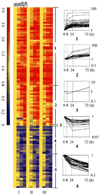
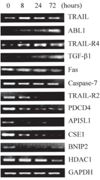
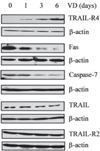
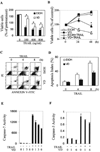
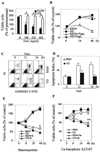
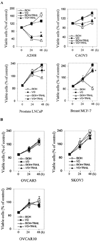

Similar articles
-
Human astrocytes are resistant to Fas ligand and tumor necrosis factor-related apoptosis-inducing ligand-induced apoptosis.J Neurosci. 2006 Mar 22;26(12):3299-308. doi: 10.1523/JNEUROSCI.5572-05.2006. J Neurosci. 2006. PMID: 16554480 Free PMC article.
-
Contribution of epigenetic silencing of tumor necrosis factor-related apoptosis inducing ligand receptor 1 (DR4) to TRAIL resistance and ovarian cancer.Mol Cancer Res. 2005 Jun;3(6):335-43. doi: 10.1158/1541-7786.MCR-04-0136. Mol Cancer Res. 2005. PMID: 15972852
-
Death receptors and ligands in cervical carcinogenesis: an immunohistochemical study.Gynecol Oncol. 2005 Mar;96(3):705-13. doi: 10.1016/j.ygyno.2004.10.046. Gynecol Oncol. 2005. PMID: 15721415
-
Cell surface Death Receptor signaling in normal and cancer cells.Semin Cancer Biol. 2003 Apr;13(2):135-47. doi: 10.1016/s1044-579x(02)00131-1. Semin Cancer Biol. 2003. PMID: 12654257 Review.
-
The role of apoptosis-inducing receptors of the tumor necrosis factor family in thyroid cancer.J Endocrinol. 2003 Aug;178(2):205-16. doi: 10.1677/joe.0.1780205. J Endocrinol. 2003. PMID: 12904168 Review.
Cited by
-
Serum 25-hydroxyvitamin D concentrations and their impact on all-cause mortality in Parkinson's disease: insights from National Health and Nutrition Examination Survey 1999-2020 data.Front Nutr. 2024 Aug 9;11:1423651. doi: 10.3389/fnut.2024.1423651. eCollection 2024. Front Nutr. 2024. PMID: 39183989 Free PMC article.
-
Genome-wide approaches for identification of nuclear receptor target genes.Nucl Recept Signal. 2006;4:e018. doi: 10.1621/nrs.04018. Epub 2006 Jul 7. Nucl Recept Signal. 2006. PMID: 16862224 Free PMC article.
-
The coupling of epidermal growth factor receptor down regulation by 1alpha,25-dihydroxyvitamin D3 to the hormone-induced cell cycle arrest at the G1-S checkpoint in ovarian cancer cells.Mol Cell Endocrinol. 2011 May 16;338(1-2):58-67. doi: 10.1016/j.mce.2011.02.023. Epub 2011 Mar 30. Mol Cell Endocrinol. 2011. PMID: 21458521 Free PMC article.
-
Vitamin D supplementation for patients with multiple sclerosis treated with interferon-beta: a randomized controlled trial assessing the effect on flu-like symptoms and immunomodulatory properties.BMC Neurol. 2013 Jun 14;13:60. doi: 10.1186/1471-2377-13-60. BMC Neurol. 2013. PMID: 23767916 Free PMC article. Clinical Trial.
-
Calcitriol stimulates gene expression of cathelicidin antimicrobial peptide in breast cancer cells with different phenotype.J Biomed Sci. 2016 Nov 10;23(1):78. doi: 10.1186/s12929-016-0298-4. J Biomed Sci. 2016. PMID: 27832772 Free PMC article.
References
-
- Webb AR, Kline L, Holick MF. J. Clin. Endocrinol. Metab. 1988;67:373–378. - PubMed
-
- Muir C, Waterhouse J, Mack T, Powell J, Whelan S. Cancer Incidence in Five Continents, International Agency for Research on Cancer Control (IARC), Scientific Publication No. 88. Vol. V. Lyon, France: IARC; 1987.
-
- Devesa SS, Grauman MA, Blot WJ, Pennello GA, Hoover RN, Fraumeni JF., Jr . Atlas of Cancer Mortality in the United States. Bethesda, MD: National Institutes of Health Publication No. 99-4564, NCI, National Institutes of Health; 1999.
-
- Jiang F, Li P, Fornace AJ, Jr, Nicosia SV, Bai W. J. Biol. Chem. 2003;278:48030–48040. - PubMed
-
- Miettinen S, Ahonen MH, Lou YR, Manninen T, Tuohimaa P, Syvala H, Ylikomi T. Int. J. Cancer. 2004;108:367–373. - PubMed
Publication types
MeSH terms
Substances
Grants and funding
LinkOut - more resources
Full Text Sources
Medical
Molecular Biology Databases
Research Materials
Miscellaneous

